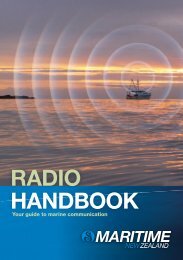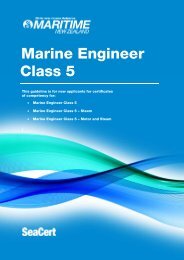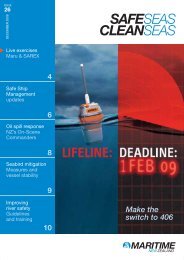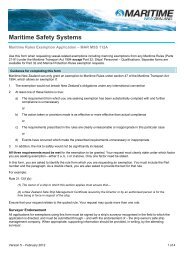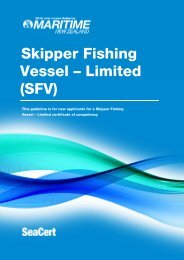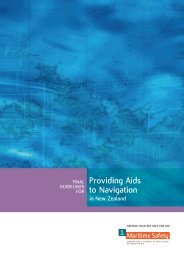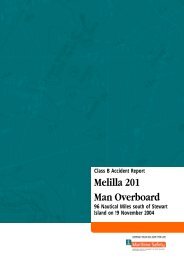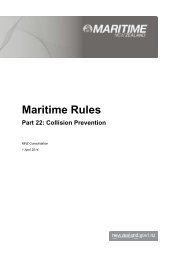New Zealand oil spill response strategy - Maritime New Zealand
New Zealand oil spill response strategy - Maritime New Zealand
New Zealand oil spill response strategy - Maritime New Zealand
Create successful ePaper yourself
Turn your PDF publications into a flip-book with our unique Google optimized e-Paper software.
In addition, <strong>Maritime</strong> <strong>New</strong> <strong>Zealand</strong> will maintain a <strong>response</strong> resource database as part of the National<br />
Marine Oil Spill Contingency Plan. This will include all <strong>oil</strong> <strong>spill</strong> <strong>response</strong> equipment held by <strong>Maritime</strong><br />
<strong>New</strong> <strong>Zealand</strong> and other agencies as appropriate, and all trained <strong>oil</strong> <strong>spill</strong> responders.<br />
Where appropriate, <strong>Maritime</strong> <strong>New</strong> <strong>Zealand</strong> will use and promote information technology to improve<br />
management of contingency plans and <strong>response</strong> activities (e.g., the establishment of a ‘live’ incident<br />
<strong>response</strong> website).<br />
In recognition of the requirement for Geospatial Information (GI) for both <strong>oil</strong> <strong>spill</strong>s and search and<br />
rescue, the cross government approach for data sharing and data development will be further<br />
facilitated. This will enable a complete ‘information systems’ approach to be used throughout<br />
<strong>Maritime</strong> <strong>New</strong> <strong>Zealand</strong>, and in particular by the <strong>spill</strong> responders throughout the country. The purpose<br />
of such a system is to aid decisions both ‘on scene’ and within the DAT.<br />
Furthermore, the situational awareness at both sites should be improved to the point where real time<br />
data flows (of dynamic data) will superimpose over static data stored at each site. This should<br />
enhance the NOSC’s downward communication to working groups and the Director’s upward<br />
communication to the Minister in a Tier 3 situation. The ultimate benefit will be the communication<br />
between NOSC and the Director.<br />
The Rescue Co-ordination Centre <strong>New</strong> <strong>Zealand</strong><br />
<strong>Maritime</strong> <strong>New</strong> <strong>Zealand</strong> now has responsibility for national search and rescue operations, which are<br />
administered from the facilities of the Rescue Co-ordination Centre <strong>New</strong> <strong>Zealand</strong> (RCCNZ). Though<br />
primarily focused on search and rescue activities, RCCNZ also undertakes some marine <strong>oil</strong> <strong>spill</strong><br />
<strong>response</strong> functions. This includes being the first point of contact for <strong>oil</strong> <strong>spill</strong>s (both actual and<br />
probable), the promulgation of this information to the appropriate authorities and the subsequent<br />
facilitation of communication with the vessels involved.<br />
<strong>Maritime</strong> Security<br />
<strong>Maritime</strong> <strong>New</strong> <strong>Zealand</strong>’s <strong>Maritime</strong> Security Team is responsible for the regulation of <strong>New</strong> <strong>Zealand</strong>'s<br />
International Ship and Port Facility Security (ISPS) Code compliant ports and ships. The organisation<br />
has no immediate <strong>response</strong> capability function for security, so it aims to ensure that the operating<br />
environment for international maritime trade in <strong>New</strong> <strong>Zealand</strong> is secure against terrorist threats, and is<br />
achieved through a whole of government approach to securing <strong>New</strong> <strong>Zealand</strong>'s borders from such<br />
activity.<br />
Response issues concerning access to secure port areas should be addressed at the contingency<br />
planning stage and detailed in Tier 2 plans.<br />
24





